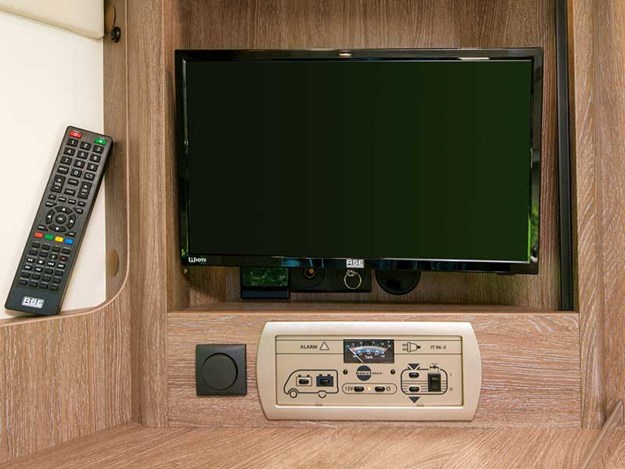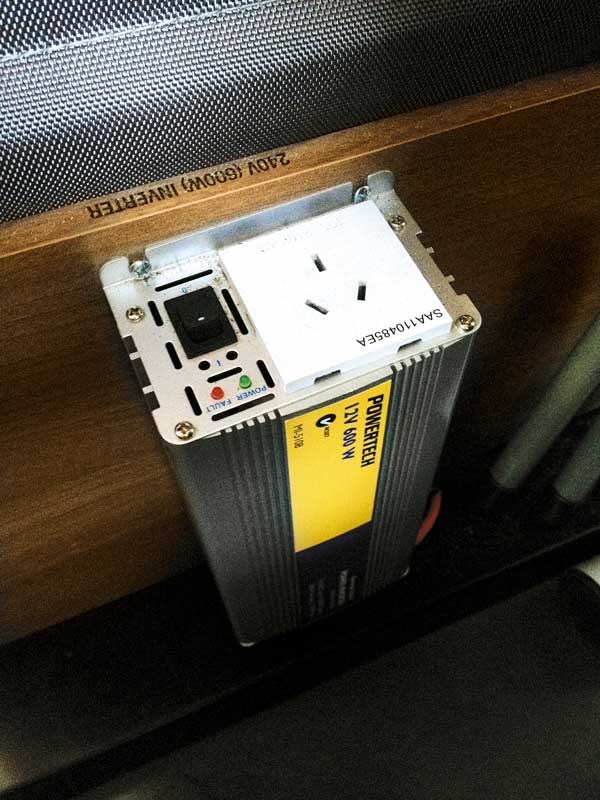A DC to AC inverter is a clever device that allows us to use appliances that run on ‘home electricity’ in our RVs using our batteries. Inverters convert direct current (DC), like the power from an RV house battery, into alternating current (230-volt AC), the same as the wall plugs at home.

How does it work?
In simple terms, an inverter increases the 12-volt DC voltage received from the battery and changes it to AC so the power at the plug is 230-volt AC.
Interestingly, the name inverter came about because the original versions converted AC to DC before some bright spark found they could be run in reverse, providing AC power from a DC source.
Early inverters functioned electro-mechanically, made a buzzing noise, and produced a ‘square wave’. These are seldom seen today. An improved version, the ‘modified sine wave’ followed. Fridges, pumps, and fans will operate on modified sine wave AC current but they are less efficient and use up to 20 percent more power.
 |
A 22-inch TV typically rates round 40 amp |
Being noisier/rougher than pure sine wave, modified sine wave can affect electronic clocks, timers, and temperature controls so they may not work correctly, or may not work at all. Today, transistors and semiconductors have replaced the mechanical components in inverters.
Filters, inductors, and capacitors have smoothed out the steps of the sine wave to the extent that some inverters have a smoother sine wave than household power supply. With their sophisticated electronics, pure sine wave inverters can power modern electronic equipment and allow electric motor driven devices to operate to their full capacity.
What kind of power inverter is the right one?
 |
A coffee capsule machine typically uses 1200 watts |
The input voltage of the inverter must match the voltage of the battery(s) being used. In most Kiwi RVs, this is 12 volts but in some, it’s 24 volts. The next step is to decide the output wattage of the inverter.
Output wattage should accommodate both the start-up surge wattage and the running wattage. Each device/appliance is usually labelled, showing its running wattage. ‘Surge wattage’ figures for appliances/devices can be difficult to obtain but the reseller or agent for the product can usually provide them.
Using multiple devices simultaneously? Add their wattages together. For example, a TV set (50 watts) and a capsule coffee machine (1000 watts) gives a total of 1050 running watts.
Inverter overload ‘surge wattage’ is measured in watts and seconds, i.e. the inverter may tolerate a start-up surge wattage of 30 percent more than the running wattage for 10 seconds, e.g. a 1200-watt inverter may tolerate a 1560-watt load for 10 seconds.
Using the example above of the capsule coffee machine, say the start-up surge is 500 watts per 10 secs and the TV start-up surge is 150 watts per five seconds. If the coffee machine is switched on first and the TV is switched on after, the coffee machine is past its surge phase; then this 1200-watt inverter would be sufficient.
Generally speaking, higher-quality inverters tolerate larger surge loads for a longer period of time. High operating temperatures are not good for electronic equipment. An inverter operating within its capacity will run cooler and last longer than one operating at its upper limit.
Battery capacity
 |
A Powertech inverter |
Inverter (mis)use can impose heavy loads on the house battery(s) causing a significant and rapid voltage drop. Inverter manufacturers usually build in an automatic low voltage disconnect between 10 and 11 volts to protect the inverter but this is too low to protect the battery(s). Some inverters allow recalibration to nearer 12 volts to protect the batteries.
A rule of thumb method of calculating the battery capacity required on an RV is to calculate the maximum wattage load expected by the inverter and, for a 12-volt system, divide this sum by five, and for a 24-volt system, divide by 10. The answer in both cases is in amp/hours, i.e. 1400 watts/5 = 280 amp/hours battery capacity needed to successfully run the inverter under continuous loads until the desired depth of discharge is reached.
Installation
Install the inverter as close to the batteries as possible and connect them together with the appropriate heavy-duty cabling to eliminate voltage drop and high resistance heat build-up. Install appropriate circuit protection i.e. a circuit breaker or a heavy-duty fuse.
Summary
While buying and fitting an inverter to an RV can be a DIY job, there are traps for the unwary. Get it right and you will be rewarded with long-lived house batteries and loads of power. Getting it wrong and it can be expensive. If in doubt, seek expert advice.





